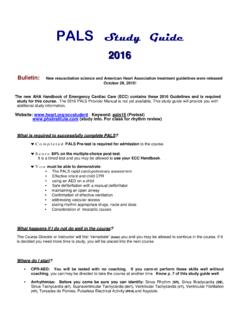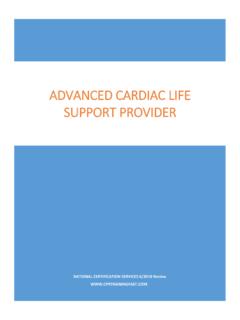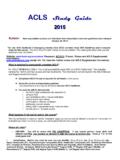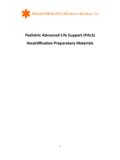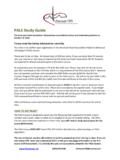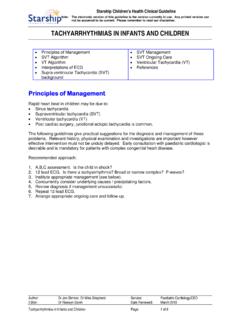Transcription of It is our pleasure to present to you this work as a …
1 2It is our pleasure to present to you this work as a result of team work of the national CPR committee at the Saudi Heart Association (SHA).We adapted the 2010 guidelines as per International Liason Commission Of Resuscitation (ILCOR) which was published October, 2010. We modi ed some of the items of 2005 guidelines and kept some as it is depending on our national need in the kingdom of Saudi Arabia. As an example, the sequence of in children and infants should not change because most common cause of child and/or infant arrest is respiratory, so respiratory assessment should take place at the the international resuscitation science since 2010 till 2012, there is a great emphasis on the early CPR and early de brillation which make di erence between life and death, good outcome and bad outcome of in hospital CPR.
2 There is also a great emphasis on CPR awareness to the community through the skillful is our pleasure to present to you this work as a result of team work of the national CPR committee at the Saudi Heart Association (SHA).We adapted the 2010 guidelines as per International Liason Commission Of Resuscitation (ILCOR) which was published October, 2010. We modi ed some of the items of 2005 guidelines and kept some as it is depending on our national need in the kingdom of Saudi Arabia. As an example, the sequence of in children and infants should not change because most common cause of child and/or infant arrest is respiratory, so respiratory assessment should take place at the the international resuscitation science since 2010 till 2012, there is a great emphasis on the early CPR and early de brillation which make di erence between life and death, good outcome and bad outcome of in hospital CPR.
3 There is also a great emphasis on CPR awareness to the community through the skillful CPRC ommittee Members34 ADULT BASIC LIFE SUPPORT(PRE-HOSPITAL)UNRESPONSIVE? Shout for help / Call 997 and AED look for breathing e ortNOT BREATHING NORMALLY? OR GASPING BREATH 30 chest compressions Look, listen, feel (if HCP or trained layperson)OPEN AIRWAYGo for ABC assessment2 rescue breaths (if HCP or trained layperson) 30 compressionsRepete this step until EMS arrives or unable to proceed 45IN HOSPITALRESUSCITATIONC ollapsed / Sick patientShout for HELP & assess patient / call for de brillator Signs of life?NOCall resuscitation team CPR 30:2 with oxygen & airway adjuncts Apply pads/monitor Attempt de brillation If appropriate Advanced life Support when resuscitation team arrives YESA ssess ABCDER ecognize & treat Oxygen, monitoring, iv access Call resuscitation team If appropriateOr rst response team (FRT) Handover to resuscitation team or FRT 56 Unresponsive?
4 Shout for Help Open Airway2 rescue breaths, 30 chest compression if one rescue Look, listen, feel (if HCP or trained layperson)Not breathing normally? No signs of life? PEDIATRIC BASICLIFE SUPPORTCall cardiac arrest team or Pediatric ALS team67 Unresponsive? Shout for Help Open Airway2 rescue breaths, 30 chest compression if one rescue Look, listen, feel (if HCP or trained layperson)Not breathing normally? No signs of life? PEDIATRIC BASICLIFE SUPPORTCall cardiac arrest team or Pediatric ALS teamAssess Severity Severe AirwayObstruction(ine ective cough) Mild AirwayObstruction(e ective cough) ADULT FOREIGN BODY AIRWAYOBSTRUCTION TREATMENTU nconscious ConsciousStart CPR5 abdominal thrustsrepeatedlyEncourage Cough Continue to check for deterioration to ine ective cough or until obstruction Severity Severe AirwayObstruction(ine ective cough) Mild AirwayObstruction(e ective cough) Unconscious ConsciousOpen airway 2 breaths Start CPRE ncourage Cough Continue to check for deterioration to ine ective cough or until obstruction relieved.
5 (5 back blows 5 chest thrusts for infant) (5 abdominal thrusts for child > 1 year)PAEDIATRIC FOREIGN BODY AIRWAY OBSTRUCTION TREATMENT89 Assess Severity Severe AirwayObstruction(ine ective cough) Mild AirwayObstruction(ine ective cough) Unconscious ConsciousOpen airway 2 breaths Start CPRE ncourage Cough Continue to check for deterioration to ine ective cough or until obstruction relieved.(5 back blows 5 chest thrusts for infant) (5 abdominal thrusts for child > 1 year)PAEDIATRIC FOREIGN BODY AIRWAY OBSTRUCTION TREATMENTU nresponsive?Call 997 and AEDLook for Breathing E ortNot breathing normally/or gasping breath CPR 30:2 Until AED is attached AED Assesses RythmShock Advised 1 Shock Immediately resume: CPR 30:2 for 2 min Immediately resume: CPR 30:2 for 2 min No Shock Advised Continue until the victim starts to wake up: to move, open eyes and to breathe normally AUTOMATED EXTERNAL DEFIBRILLATION ALGORITHM910 Call Resuscitation Team Unresponsive?
6 Not breathing or only occasional gasps CPR 30:2 Attach de brillator/monitor Minimize interruptionsAED Assesses RythmShockable(VF /Pulseless VT)Return OfSpontaneousCirculation1 Shock Immediately resume: CPR 30:2 for 2 min Minimize interruptions Immediately resume: CPR 30:2 for 2 min Minimize interruptions No Shock Advised ADVANCED LIFE SUPPORTI mmediate Post Cardiac Arrest Treatment- Use ABCDE approach. - Controlled Oxygenation and 12 lead ECG. - Treat precipitating cause. - Temperature control / Therapeutic hypothermia. - Entidal Co2 monitoring. DURING CPR Ensure high-quality CPR: rate, depth, recoil Plan actions before interrupting CPR Give oxygen Consider advanced airway and capnography Continuous chest compressions when advanced airway In place Vascular access intravenous, intraosseous) Give epinephrine every 3-5 min Amiodarone 300 mg IV bolus for refractory VF/pulseless VT Correct reversible causes REVERSIBLE CAUSES Hypoxia Hypervolemia Hypo- / hyperkalemia / metabolic Hypothermia Thrombosis - coronary or pulmonary Tamponade - cardiac Toxins Tension pneumothorax 1011 Call Resuscitation Team Unresponsive?
7 Not breathing or only occasional gasps CPR 30:2 Attach de brillator/monitor Minimize interruptionsAED Assesses RythmShockable(VF /Pulseless VT)Return OfSpontaneousCirculation1 Shock Immediately resume: CPR 30:2 for 2 min Minimize interruptions Immediately resume: CPR 30:2 for 2 min Minimize interruptions No Shock Advised ADVANCED LIFE SUPPORTI mmediate Post Cardiac Arrest Treatment- Use ABCDE approach. - Controlled Oxygenation and 12 lead ECG. - Treat precipitating cause. - Temperature control / Therapeutic hypothermia. - Entidal Co2 monitoring. DURING CPR Ensure high-quality CPR: rate, depth, recoil Plan actions before interrupting CPR Give oxygen Consider advanced airway and capnography Continuous chest compressions when advanced airway In place Vascular access intravenous, intraosseous) Give epinephrine every 3-5 min Amiodarone 300 mg IV bolus for refractory VF/pulseless VT Correct reversible causes REVERSIBLE CAUSES Hypoxia Hypervolemia Hypo- / hyperkalemia / metabolic Hypothermia Thrombosis - coronary or pulmonary Tamponade - cardiac Toxins Tension pneumothorax ACS ALGORITHM (DIAGNOSES)ST Elevation12 Lead ECGO ther ECG alterations(or normal ECG) mV In 2 adjacent limb leads and/ or mV in adjacent chest leads or (presumably)
8 New LBBB = UA if troponins remain negative= NSTEMI if troponins (T or I) positive Non-STEMI-ACSHigh risk - Dynamic ECG changes - ST depression - Hemodynamic/rhythm Instability - Diabetes mellitus STEMIP atient with clinical signs & symptoms of ACS1112 ACS ALGORITHM (TREATMENT)ECGPain ReliefNitroglycerin if systolic BP > 90 mmHg Morphine (repeated doses) of 3-5 mg until pain freeAntiplatelet Treatment 16o-325mg Acetylsalicylic acid chewed tablet75 - 600 mg Clopidogrel according to strategy*OXYGEN THERAPYif Spo2 < 94 % Non-STEMI-ACSSTEMIA ccording to risk strati cation: Antiplatelet therapy Antianginal therapy Antithrombin therapy Serial cardiac enzymes Reperfusion for high riskPCI preferred if:Within the time window & availability of highly specialized for thrombolytic therapy, cardiogenic shock (or severe left ventricular failure)Thrombolysis preferred if:No contraindications and inappropriate delay to PCI1213 ACS ALGORITHM (TREATMENT)ECGPain ReliefNitroglycerin if systolic BP > 90 mmHg Morphine (repeated doses) of 3-5 mg until pain freeAntiplatelet Treatment 16o-325mg Acetylsalicylic acid chewed tablet75 - 600 mg Clopidogrel according to strategy*OXYGEN THERAPYif Spo2 < 94 % Non-STEMI-ACSSTEMIA ccording to risk strati cation: Antiplatelet therapy Antianginal therapy Antithrombin therapy Serial cardiac enzymes Reperfusion for high riskPCI preferred if.
9 Within the time window & availability of highly specialized for thrombolytic therapy, cardiogenic shock (or severe left ventricular failure)Thrombolysis preferred if:No contraindications and inappropriate delay to PCI Assess using the ABCDE approach Ensure oxygen given and obtain IV access Monitor ECG, BP, Sp02, record12 lead ECG Identify and treat reversible causes ( electrolyte abnormalities)Interim Measure: Atropine 500 mcg IV Repeat to maximum of 3 mg Isoprenaline 5 mcg/min Epinephrine 2-10 mcg/min Alternative drugs* OR Dopamine/dobutamine infusion (alternative to transcutaneous pacing) Transcutaneous pacingRisk of Asystole?- Recent asystole- Mobitz 2 AV block - Complete heart block with broad QRS - Ventricular pause > 3s Assess for evidence of instability signs: 1.
10 Shock 2. Syncope3. Myocardial ischemia4. Heart failureSeek Expert helpArrange transvenous pacingObserveBRADYCARDIA ALGORITHMA tropine500mcg IVSatisfactory Response?YESNONOYESYESNO* Alternatives include: Aminophylline Dopamine Glucagon (if beta-blocker or calcium channel blocker overdose) 1314 Assess using the ABCDE approach Ensure oxygen given and obtain IV access Monitor ECG, BP, Sp02 ,record 12 lead ECG Identify and treat reversible causes ( electrolyte abnormalitiesAssess for evidence of instability signs: 1. Shock 2. Syncope 3. Myocardial ischemia 4. Heart failureTACHYCARDIA ALGORITHM (WITH PULSE)Synchronized DC Shock*Up to 3 attemptsIs QRS narrow (< sec)?*Attempted electrical cardioversion is always undertaken under sedation or anesthesiaStableUnstableBroad QRSIs QRS regular?)
